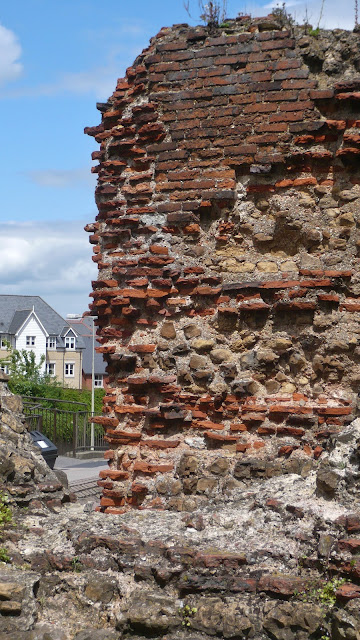'The Marquis' is a pub on the North Hill created out of a 16th century dwelling. Timber framed, black and white frontage I didn't bother picturing as the sun hid at the time. The doorway caught my attention, pub doorways do catch some of my readers attention I know, and this featured two faces, one carved into each wooden corner. Whether for decoration or some other reason I fail to say because as usual I can find no info on this building online, just details of the pub itself. However it appears they have preserved much similar woodwork inside. I have to plead poverty of course and walk past in spite of searing hunger and exhaustion.
The plastic pipe is not 16th century.
This big beast is 'Jumbo!' He once supplied the towns water but now is undergoing renovation as a home for some lucky (wealthy) person. I cut off the bottom as it is hidden behind wooden fencing etc belonging to the developers. The last time I looked every ledge all the way up was home to the pigeon, masses of them, and I suspect the first job will be to insert netting to prevent that if someone will actually live there. The view from the top must be fantastic! The town spread out beneath you, the river leading to the estuary in the distance, the roads running off in all directions and the rain clouds hiding all this from view! The Romans were not keen on the weather either!
The Romans were keen on building however and also they became very keen on defence at this spot. What is shown here are the remains of a Roman Gateway known today as the Balkerne Gate. Having invaded successfully in 43 AD the Romans settled down in their small city then known as Colonia Victricencis (City of Victory, but you knew that.) This settlement was unfortified at the time, which was unfortunate as the Roman in charge upset a woman after her man, the local King, died. He took all she had, raped her daughters and killed one or two. As we all know that sort of thing means trouble. Boudica decided to vent her wrath by burning Colonia Victricencis to the ground, along with all therein. The only building to survive was the base of the basillica, this now forms the base of the 'castle.' Rome was not best pleased. After removing the Queen of the Iceni and her threat a wall was constructed around the town. She visited in 60/61 AD and the walls have been dated to around 65-80 AD. Lucky for us this almost complete gate survived by being hidden by overgrowth which preserved it in reasonable condition. Around a hundred years ago the structure was dug out and forms a real historical connection to the Roman era we have all read about. During Victorian times the then owner of the pub next door demolished half the wall to allow his guests to see the new railway. This brought him much in the way of custom then and abuse from history lovers today! It was then the pub became known as the 'Hole in the Wall.' The floor of the gateway has been somewhat modernised to cope with visitors and occasional repairs have taken place but most of the wall dates from the first century and reveals the Roman thoroughness when it came to defence. They did enjoy their engineering did the Romans.
Before the pub landlord intervened the gate was double in size and would possibly have been dedicated to the Emperor Claudius. He had visited while claiming the victory of 43 AD and then received the surrender of the Britons there. He then hopped of home before he caught cold. He also named his son Britannicus, and hoped he would become heir, however the lad was bumped him off later to prevent this. That nice Tacitus tells us more about that intrigue. This gate, the oldest and best preserved, faced west and lined up with Londinium, a place you may have heard off. The opening on the left, a round room, possibly became the guard room but I wonder if anyone actually knows? Do tell if you know. The lads needed somewhere to hide when Joe Public was around didn't they? I love the red bricks used by the Romans. There are vast numbers on this wall, and indeed on many ancient buildings throughout areas they dominated. These strong bricks have been reused in houses, walls and church buildings and stand out well. The soldiers would have been the ones building the wall. This kept them occupied in between bashing any who may have decided to rebel. In 'Agricola,' Tacitus tells of his father in laws work in taming this island. he is accurate in every detail I am sure.
You wish a close up? Sure!
A few modern bricks inserted to stop collapse in places but the nature of the structure clear from the top of the gate. The road outside sinks away but this came from a more recent development, nevertheless the wall plus the previous ditch dug by the Britons left the defenders high above anyone who wished to attack. The name Balkerne comes from 'baulk,' as in Roman times the gate was baulked up, closed up and sealed, other gates having come into preferred use it seems. Road widening and later building or renovations have removed almost all traces of previous gates. One or two remnants remain but nothing as good as this gate. During excavations in the sixties when the road works were undertaken archaeologists discovered a great deal about the Roman occupation and later times. They decided to make use of the gate and as the roadworks involved a bridge over the roadway many people pass through today.
More, much more, can be found at Camulos and that is worth a read to those who find such things fascinating. I recommend this.
.















.JPG)
.jpg)














.JPG)












